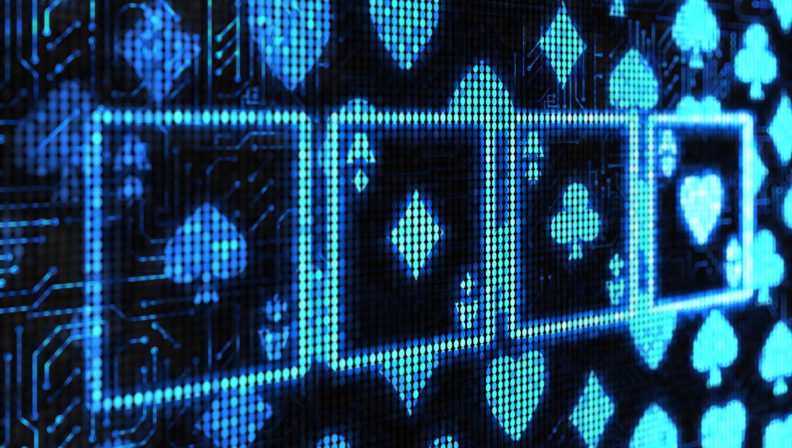
The best poker players in the world are no longer human. Developments in artificial intelligence over the last decade have made poker bots stronger than even the best professionals, being able to nearly replicate game theoretically optimal (GTO) play on the spot. But humans are capable of doing one thing better than bots – beating other humans. While GTO play is guaranteed to not lose in the long run, we can do better by observing our opponents’ tendencies and shifting our strategies away from baseline to maximize against these deviations. Poker players use GTO solvers to study baseline strategies, but these solvers can also calculate the counterstrategies that best exploit opponents. I recently played a hand that highlights how to shift from GTO to exploitative play as you learn more about your opponent’s tendencies.
We’re playing a seven handed 1/2 NLHE game. It folds to Adam in the small blind who opens to 5. I have Qc5s in the big blind and decide to call. Adam is likely opening around 40% of his range, so queen high is good enough to call in position.
The flop is 6c4c2d. This is a better board for Adam being the preflop aggressor, as he will have more strong hands like overpairs while I will have more air that doesn’t connect with this board. He bets 5 into a pot of 10 (½ pot), which the solver thinks should be done around half the time. With a gutshot straight draw and a backdoor flush draw, I have two options here. Calling is okay as I have enough equity against his entire range, but I choose to raise instead as I can represent strong hands like two pairs, sets, and straights and I need bluffs to balance out these value hands. It’s also easy to continue bluffing on later streets when I pick up equity, and having the Qc means I block some flush draws that will call and makes it less likely he has a flush when it completes. I raise to 20, and he calls.
SB on Flop
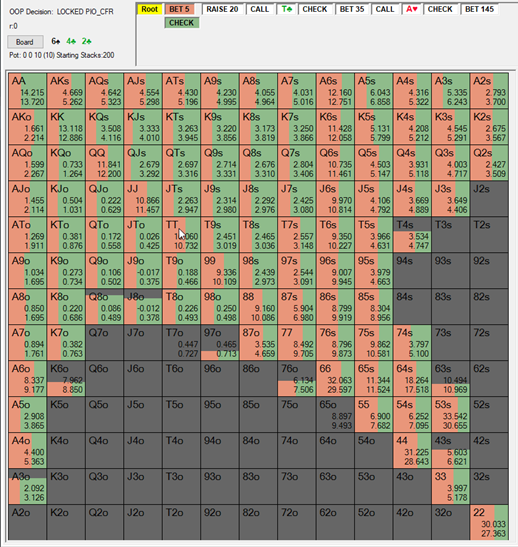
BB vs ½ pot bet on Flop
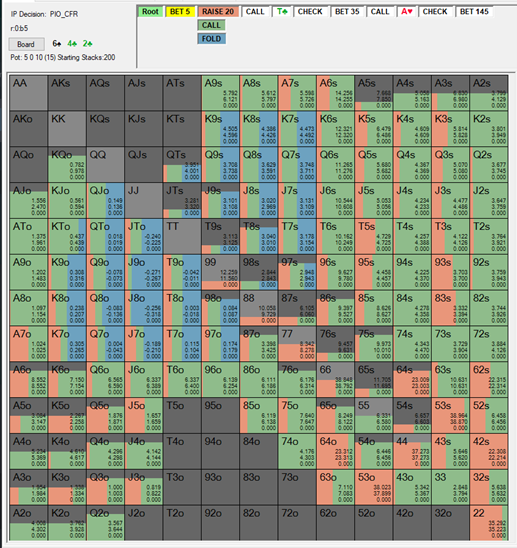
SB vs BB raise on Flop

Piosolver calculates how each combo in an overall range should be played to maximize EV. You input the different options each player has, and it will highlight how often you should take each action with specific combos and what the EV is of those action (blue=fold, green=check/call, light red=bet x% of pot, dark red=bet y%…). Hands that are shaded gray are no longer in a player’s range. On the flop, the solver says the SB should be mixing between betting ½ pot and checking with its entire range. Facing this, the BB should fold around ½ of its junk hands (97-KT), raise with overpairs, two pairs, sets, and straights for value, mix bluffs in with straight draws, flushdraws, and backdoor flushdraws, and call the rest. In response, the SB can fold most of its overcard hands, call with overcard+BDFDs, some pairs, and some SD/FDs, and raise medium overpairs, lower sets, straights, and bluffs to balance.
The turn is the Tc, bringing in the flush. This card should be better for Adam, as I call some flushes instead of raising, while he bet/calls most of his flush draws. Checking allows the BB to check back with more marginal made hands and draws that want to get a free river. This makes the SB very incentivized to lead, which the solver does 60% of the time for ¼ pot. Adam does check, so he should have less strong hands and I can continue bluffing with the flush blocker. I bet 70% pot, setting up an overbet jam on the river, and Adam calls.
SB on Turn
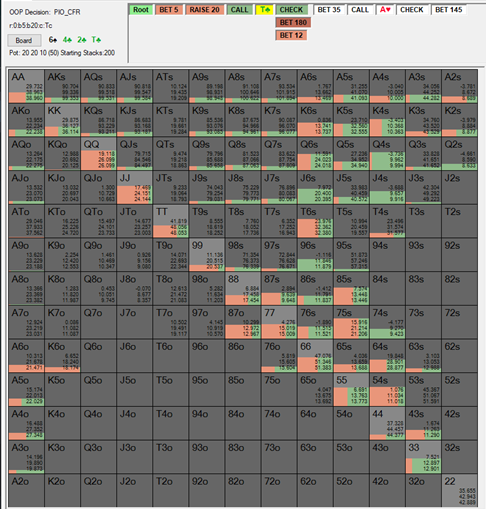
BB vs check on Turn
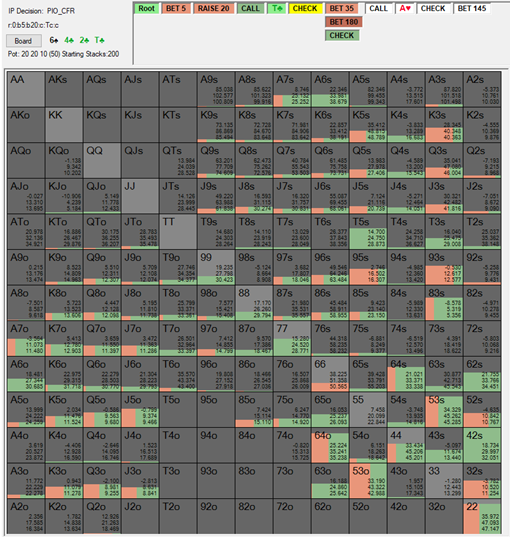
SB vs 70% pot bet on Turn
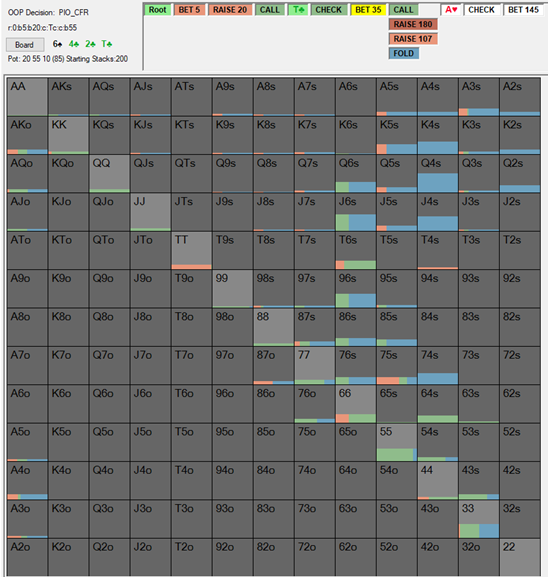
As the turn favors the SB who calls flop with more FDs, this is represented by the SB leading the turn with 60% of its range for ¼ pot. Hands that check include most one-pairs and overcards. Facing a check, the BB gets to continue betting with top set, some straights, and most flushes, mixing in bluffs with some pair+SDs and FD+SDs. The SB should start folding weaker one-pairs, call pair+SDs and overpairs, and raise some flushes and sets.
The river is the Ah, not changing much besides turning nut flush draws into top pair. Adam checks, which makes sense to do with his whole range as I have more flushes based on my aggression on previous streets. I think if I choose to bet here, I should go all in for 120% pot as I have the nut advantage with more flushes, straights, and sets. As I don’t have enough value to jam all my bluffs, the solver ends up giving up on around 80% of bluffs to stay balanced, so I need to be selective in which bluffs I continue betting. When choosing bluffs, I like blocking flushes as it makes it less likely he’s slowplaying a flush or has a bluff catcher with a club in it (ie. QcQx) that is likely to call. Additionally, my 5 blocks some made straights that he may have played passively with. For these reasons, I think my hand is a reasonable bluff and decide to go all in, although the solver thinks I should only be doing this some of the time. Unfortunately, Adam calls, having TT for a turned set.
BB vs check on River
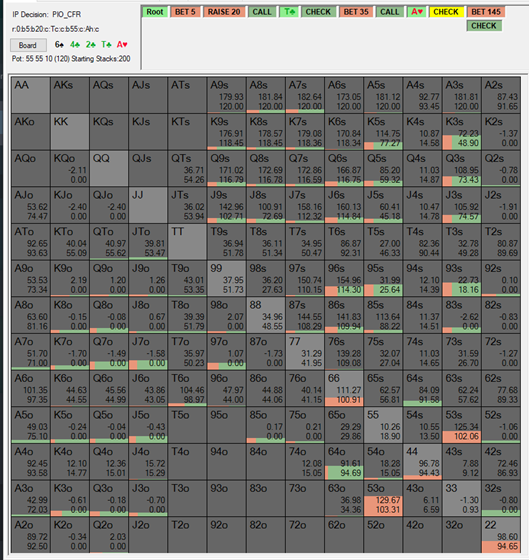
SB vs shove on River
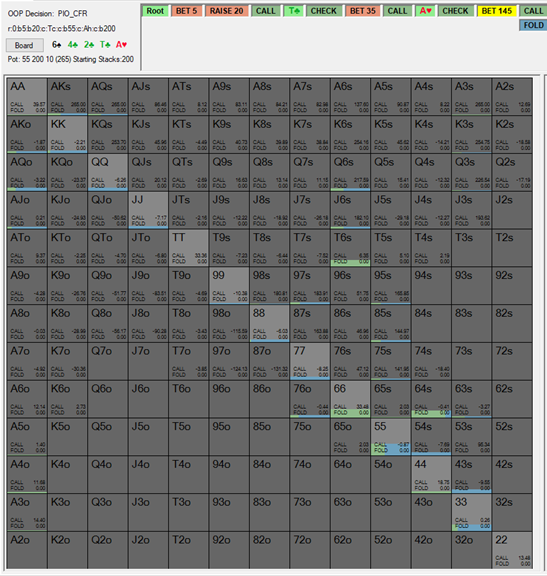
Given that the SB should not have many hands stronger than a set that take this line, the BB jams with all sets, straights, and flushes. Bluffs contain a club and are randomized for balance. The SB only defends with top pair with nutflush blocker, two pairs, and sets.
What does Adam’s play tell me about his overall strategy? He chose to call the flop instead of 3betting, and check call the turn instead of leading or check raising, while the solver likes taking the more aggressive actions at high frequencies. While we should be careful of over-extrapolating from one hand, if I notice more of a tendency to take passive options, I can exploit this leak in similar spots by lowering my aggression to reduce the value of slow playing. For instance, we can see how the solver plays in my spot if the SB never leads on the turn – the BB betting frequency drops from around 40 to 20% as the SB’s checking range is stronger. Some hands like two pair that were strong enough to go for value against a weaker range should now be checked back, so the BB must also have less bluffs to stay balanced. Maybe I could’ve saved myself two bets by checking back with my hand had I known the SB range was stronger. Note that if my opponent figures out I’ve adjusted my strategy to exploit them, they could change their strategy in a way that counters mine. If that happens, I could re-adjust to counter their new strategy and the cycle would continue until neither of us plays a strategy that is exploitable.
BB vs SB 100% check on Turn
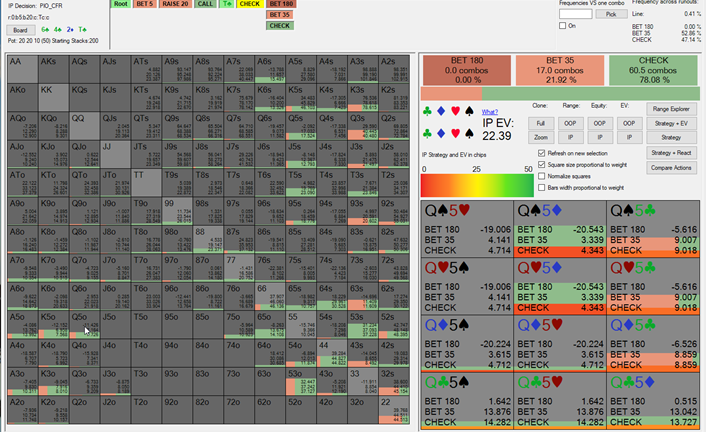
After node-locking to have the SB check turn 100%, the BB should be less aggressive, going less thin for value by checking back with more top pairs and sets. This means less bluffs, which can be seen in the relative frequency of overcard+gutshots barreling compared to the original sim. Interestingly, it seems that low card flush blockers are better bluffs as they have less equity and thus lose less by folding when the opponent c/raises. Qc5s would much rather see a free river than have to fold to a raise on the turn, so it seems checking is better here.
While game theoretic play is a useful baseline against random opponents, poker is a repeated game, and you leave money on the table by not adjusting against opponents who consistently deviate from optimal play. By paying attention to other players’ tendencies, you can increasingly shift your strategy away from baseline as you gain more confidence in the patterns you observe.

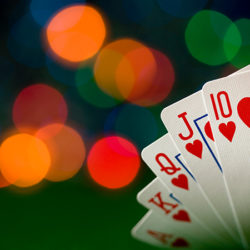

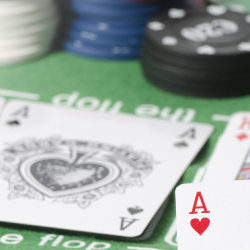
Subscribe Now
Get each new post sent straight to your inbox